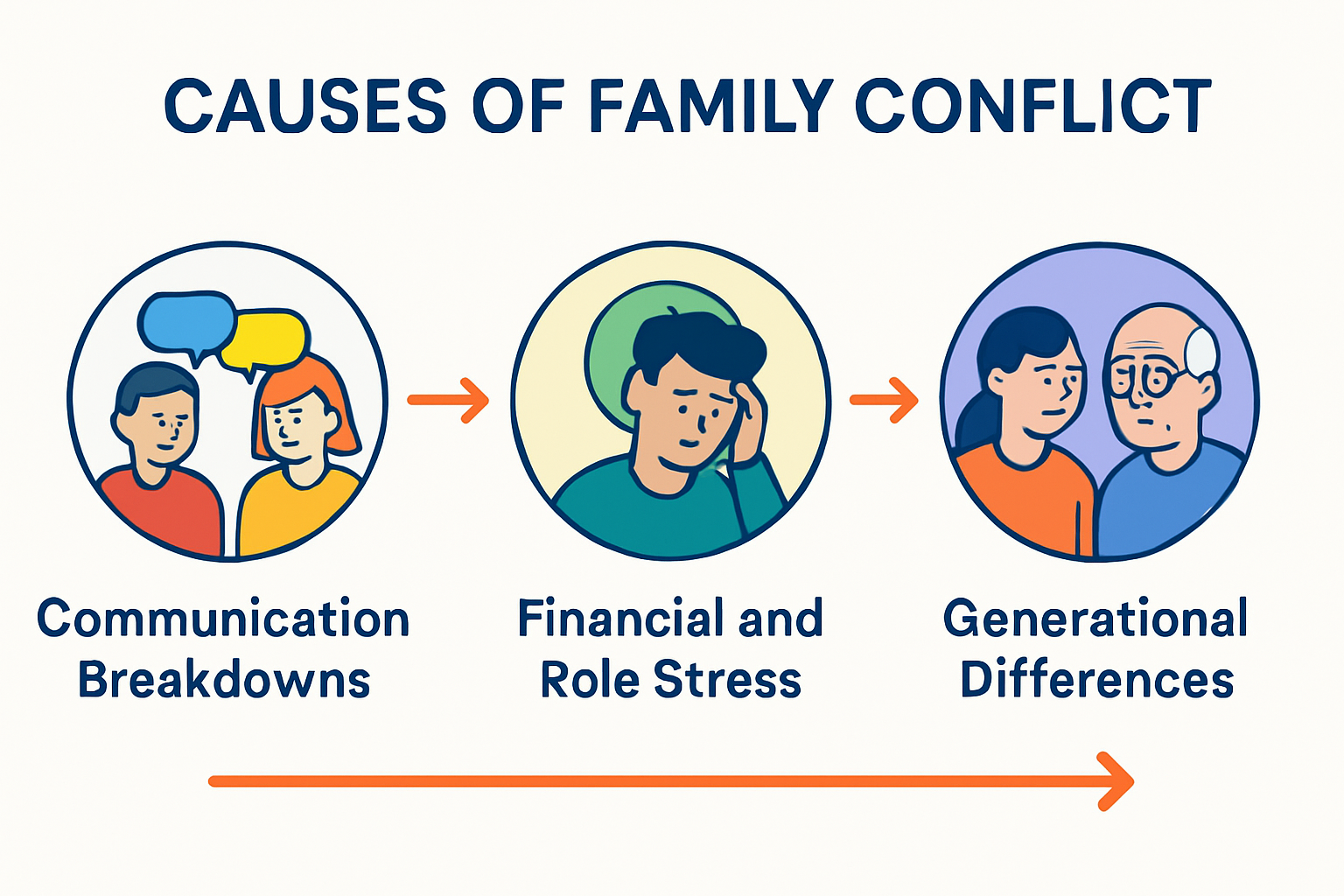Conflict Resolution for Families: Tools, Tips, and Teletherapy 2025

Family disagreements can turn a peaceful home upside down and leave lasting scars if handled poorly. Imagine this. Nearly 70 percent of families report unresolved conflicts causing ongoing tension and stress. Yet most people are surprised to learn that technology in 2025 is making it easier than ever for families to heal deep divisions without even leaving the living room.
Table of Contents
- Common Causes Of Family Conflicts
- Proven Strategies For Conflict Resolution
- Special Approaches For Couples And Parents
- Teletherapy Options For Families In 2025
Quick Summary
| Takeaway | Explanation |
|---|---|
| Understand common conflict causes | Recognizing communication breakdowns, financial stress, and generational differences helps address underlying family issues effectively. |
| Practice active listening | Engaging fully with what others say promotes understanding and prevents escalation of conflict. Use non-verbal cues to show attentiveness. |
| Adopt collaborative problem solving | Approach conflicts as shared challenges to find solutions meeting everyone’s needs, rather than competing for victory. |
| Implement emotional regulation techniques | Managing emotions during conflicts prevents destructive interactions and fosters respectful conversation. Use “I” statements to express feelings. |
| Explore teletherapy options | Digital therapy platforms provide accessible support for families, offering flexible communication tools and tailored interventions for unique dynamics. |
Common Causes of Family Conflicts
Family conflicts are complex emotional landscapes that emerge from various interconnected factors. Understanding these root causes is crucial for developing effective conflict resolution strategies. Insights into family dynamics reveal that conflicts are rarely about a single issue but often stem from deeper underlying tensions.
Communication Breakdowns
Miscommunication sits at the heart of most family conflicts. According to research from the National Institutes of Health, communication problems represent one of the most significant sources of family tension. These breakdowns occur when family members struggle to express their feelings, needs, and perspectives clearly and respectfully. Unspoken expectations, assumptions, and emotional barriers create communication walls that prevent genuine understanding.
Poor communication manifests in multiple ways. Some family members might become passive aggressive, while others resort to shouting or complete emotional withdrawal. Nonverbal cues get misinterpreted. Tone, body language, and unaddressed emotional undercurrents can escalate simple misunderstandings into full blown arguments.
Financial and Role-Related Stress
Financial pressures consistently rank among the top stressors in family systems. Disagreements about money management, spending habits, and financial priorities can create significant rifts. One partner might be a saver while another is more inclined to spend. Differing economic backgrounds and financial philosophies can lead to ongoing conflicts that erode trust and mutual respect.
Additionally, undefined or imbalanced family roles contribute to tension. Who handles household responsibilities? How are childcare duties divided? What are the expectations around work and home management? When these roles become unclear or feel fundamentally unfair, resentment builds. Family members may feel overwhelmed, underappreciated, or taken for granted.
Value and Generational Differences
Generational gaps create another significant source of family conflict. Younger and older family members often hold dramatically different worldviews, shaped by technological advances, cultural shifts, and changing social norms. Parents might struggle to understand their children’s digital lifestyles, while younger generations might feel their perspectives are dismissed or undervalued.
These value differences extend beyond technology. Perspectives on relationships, career choices, personal identity, and social issues can create profound misunderstandings. What seemed traditional and acceptable to one generation might feel restrictive or outdated to another. Without empathetic dialogue and mutual respect, these differences can create lasting emotional distance.
Recognizing these common causes of family conflicts is the first step toward meaningful resolution. By understanding the complex dynamics that underlie family tensions, individuals can approach conflicts with greater compassion, strategic communication, and a commitment to mutual understanding.
Here is a table summarizing the primary causes of family conflict and their key characteristics:
| Cause of Conflict | Key Characteristics |
|---|---|
| Communication Breakdowns | Misunderstandings, passive aggression, lack of clear expression, misinterpretation of cues |
| Financial & Role-Related Stress | Disagreements on money management, unclear family roles, imbalance in duties, resentment over responsibilities |
| Value & Generational Differences | Clashing worldviews, differing perspectives shaped by age, conflicts over traditions, technology use, social issues |
Proven Strategies for Conflict Resolution

Conflict resolution requires intentional approaches that transform disagreements into opportunities for understanding and growth. Practical conflict management techniques can help families navigate challenging emotional landscapes with greater empathy and effectiveness.
Active Listening and Empathetic Communication
Active listening forms the cornerstone of successful conflict resolution. According to research from the MGH Clay Center, truly hearing and understanding another person’s perspective is fundamental to resolving family tensions. This means setting aside personal defensiveness and genuinely attempting to comprehend the underlying emotions and needs driving the conflict.
Effective active listening involves several key techniques. First, family members must focus entirely on the speaker without interrupting. Maintain eye contact, use open body language, and provide verbal and nonverbal cues that demonstrate engagement. Reflect back what you hear by paraphrasing the speaker’s words to confirm understanding. Ask clarifying questions that help unpack the deeper feelings behind the surface-level disagreement.
Collaborative Problem Solving
The Better Health Channel emphasizes the importance of collaborative problem solving in family conflict resolution. This approach moves beyond win-lose scenarios to create solutions that address everyone’s core needs and concerns. It requires family members to approach conflicts as shared challenges to be solved together, rather than battles to be won.
The collaborative problem-solving process involves several critical steps. Begin by clearly defining the actual problem without blame or accusation. Encourage each family member to share their perspective and underlying concerns. Brainstorm potential solutions together, focusing on creativity and mutual benefit. Evaluate these solutions objectively, considering their potential impact on all family members. Select an approach that feels fair and addresses the root issues.
Emotional Regulation and Respectful Communication
Emotional regulation is a crucial skill in conflict resolution. According to CYC-Net’s research, families that practice emotional control can transform potentially destructive conflicts into constructive dialogues. This means learning to recognize and manage intense emotional reactions before they escalate into harmful communication patterns.
Practical emotional regulation techniques include taking deliberate pauses during heated moments, practicing deep breathing, and using “I” statements that express feelings without attacking others. Acknowledge emotions without letting them control the conversation. Recognize that strong feelings are valid, but how they are expressed matters tremendously. Establish family agreements about communication boundaries, such as avoiding personal attacks, maintaining respectful tones, and giving each other space when emotions run high.
By implementing these proven strategies, families can transform conflict from a source of stress and division into an opportunity for deeper understanding, personal growth, and strengthened relationships. The key lies in approaching conflicts with patience, empathy, and a genuine commitment to mutual respect and collaborative problem solving.
Below is a table summarizing the main conflict resolution strategies and their essential components:
| Strategy | Key Components |
|---|---|
| Active Listening & Empathetic Communication | Full attention, nonverbal engagement, paraphrasing, clarifying questions |
| Collaborative Problem Solving | Define issue without blame, share perspectives, brainstorm together, evaluate options, fair solution |
| Emotional Regulation & Respectful Communication | Pause, deep breathing, “I” statements, emotional awareness, set communication boundaries |
Special Approaches for Couples and Parents
Couples and parents face unique challenges in conflict resolution that require specialized strategies and nuanced understanding. Advanced relationship communication techniques can transform potential relationship fractures into opportunities for deeper connection and mutual understanding.
Parental Conflict Management Strategies
The Raising Children Network emphasizes the critical importance of constructive conflict resolution for parents. Children are highly sensitive to parental tensions, and unresolved conflicts can significantly impact their emotional development. Effective parental conflict management requires a deliberate, strategic approach that prioritizes respectful communication and collaborative problem solving.
Key strategies include establishing clear communication protocols during disagreements. Parents should model healthy conflict resolution by using “I” statements that express feelings without blame. For instance, instead of saying “You never help with household chores,” a more constructive approach would be “I feel overwhelmed when household responsibilities feel unbalanced.” This approach creates space for dialogue rather than defensiveness.
Mental Health Considerations in Family Conflicts
The Conflict Compass Program highlights the intricate relationship between mental health and family dynamics. Conflicts within couples and families often involve complex emotional landscapes where mental health plays a significant role. Understanding and addressing underlying mental health challenges becomes crucial in developing effective resolution strategies.
Practitioners recommend a holistic approach that considers individual mental health needs. This might involve creating safe spaces for open dialogue about emotional experiences, recognizing potential mental health triggers, and developing mutual support strategies. Couples and parents should be prepared to seek professional guidance when conflicts seem deeply rooted in psychological challenges. Professional counseling can provide tools for understanding each other’s emotional experiences and developing healthier communication patterns.
Systemic Approach to Family Conflict Resolution
UK Government research suggests a systemic approach to family conflict resolution that goes beyond immediate problem solving. This approach views the family as an interconnected system where each member’s actions and emotions impact the entire unit.
A systemic approach involves several key principles. First, recognize that conflicts are rarely about a single issue but often represent deeper relational dynamics. Develop a collaborative mindset that sees conflicts as shared challenges to be solved together. Practice empathy by attempting to understand each family member’s perspective, including children’s experiences. Create family agreements about communication boundaries, emotional support, and conflict resolution processes.
Implementing these specialized approaches requires patience, commitment, and a willingness to grow together. By adopting strategic communication techniques, addressing mental health considerations, and viewing conflicts through a systemic lens, couples and parents can transform potential sources of tension into opportunities for deeper understanding and stronger relationships.
Teletherapy Options for Families in 2025
Teletherapy has transformed family conflict resolution, offering unprecedented accessibility and convenience for families seeking professional support. Innovative digital therapy solutions have revolutionized how families address complex emotional challenges and communication barriers.
Digital Platforms and Therapeutic Approaches
Research from the UK Department for Work and Pensions highlights the emergence of specialized digital interventions designed to support family conflict resolution. Cutting-edge platforms now offer comprehensive therapeutic experiences that go beyond traditional video consultations. These include interactive workshops, digital assessment tools, and personalized communication skill-building modules that families can access from the comfort of their homes.
Modern teletherapy platforms integrate multiple communication channels. Families can choose between video sessions, secure messaging, collaborative digital workspaces, and asynchronous therapeutic tools. This flexibility allows participants to engage with therapeutic content in ways that best suit their schedules, learning styles, and comfort levels. Some platforms even offer AI-assisted communication analysis that provides real-time feedback on communication patterns and emotional dynamics.
Specialized Therapeutic Interventions
A case study published in the Journal of Systemic Therapies demonstrates the remarkable potential of targeted teletherapy interventions. Cognitive-behavioral approaches delivered through digital platforms have shown significant success in addressing complex family dynamics, particularly for adolescents and young adults struggling with anxiety, communication challenges, and interpersonal conflicts.
Specialized teletherapy options now cater to diverse family configurations and unique therapeutic needs. These include targeted programs for blended families, cross-generational conflict resolution, co-parenting support, and interventions designed for families experiencing significant life transitions. Therapists can now provide nuanced, culturally sensitive support that acknowledges the specific dynamics of different family structures and backgrounds.
Technological Innovations and Therapeutic Effectiveness

Research published in the Journal of Marital and Family Therapy underscores the continuous evolution of teletherapy technologies. While digital platforms initially emerged as emergency alternatives during the pandemic, they have since developed into sophisticated therapeutic tools. Advanced encryption, secure platforms, and sophisticated screening mechanisms ensure client privacy and data protection.
Technological innovations have expanded the reach of family therapy beyond traditional geographical limitations. Families can now connect with specialized therapists regardless of their physical location, making expert support more accessible than ever. Machine learning algorithms help match families with therapists who have specific expertise relevant to their unique challenges, creating more personalized and effective therapeutic experiences.
As teletherapy continues to evolve, it promises to democratize access to high-quality family conflict resolution support. By combining technological innovation with sophisticated therapeutic approaches, these digital platforms offer hope and practical solutions for families navigating complex emotional landscapes. The future of family therapy is not just digital it is personalized, accessible, and transformative.
Frequently Asked Questions
What are the common causes of family conflicts?
Family conflicts often arise from communication breakdowns, financial and role-related stress, and value and generational differences. Understanding these causes is crucial for addressing underlying issues effectively.
How can families practice effective conflict resolution?
Families can enhance conflict resolution by using active listening and empathetic communication, adopting collaborative problem-solving techniques, and implementing emotional regulation strategies to communicate respectfully.
What specialized strategies are available for parents and couples?
Parents and couples can benefit from conflict management strategies such as modeling healthy communication, addressing mental health considerations during conflicts, and adopting a systemic approach that views the family as an interconnected unit.
How does teletherapy support family conflict resolution in 2025?
Teletherapy offers families accessible, flexible support through digital platforms. These platforms provide interactive tools, specialized therapeutic interventions, and personalized communication skills training, helping families manage conflicts from the comfort of their homes.
Take the Next Step Toward a Healthier Family Dynamic
Family conflicts can feel overwhelming, especially when unresolved issues like emotional distance, miscommunication, or generational differences begin to damage your most important relationships. Reading through proven strategies such as active listening, empathetic communication, and emotional regulation can open the door to real change. But the truth is, many families need expert guidance and practical tools to break old patterns and start healing for good. If you are ready to move from knowledge to action, you do not have to do it alone.

Start your journey toward stronger family relationships with personalized support. Mastering Conflict offers online family counseling and specialized anger management programs, all led by experienced professionals using evidence-based approaches. Take charge of your family’s well-being today by exploring our services, scheduling a confidential consultation, or learning more through our trusted digital resources. Visit https://masteringconflict.com and give your loved ones the future they deserve. Now is the time to invest in lasting peace and connection.

124 Responses